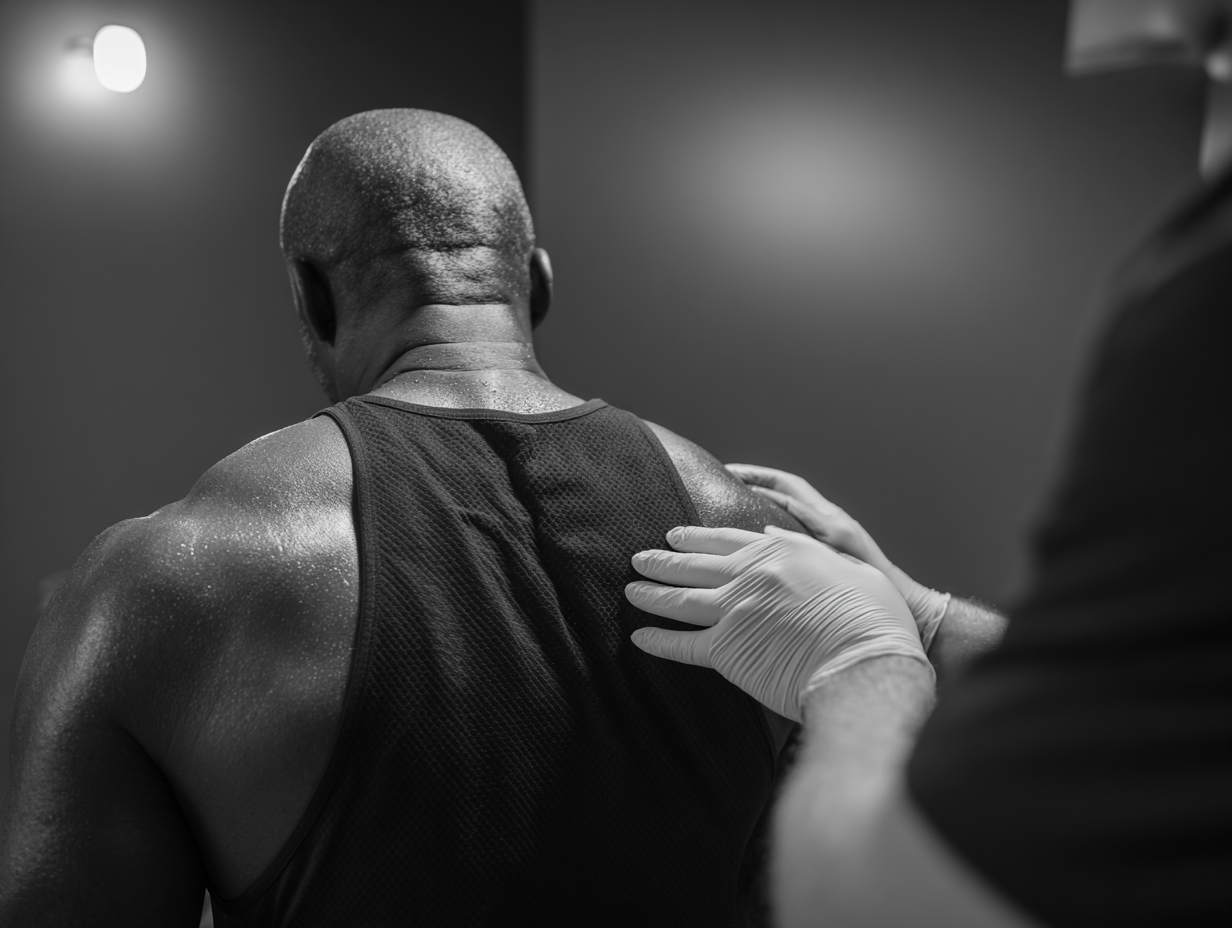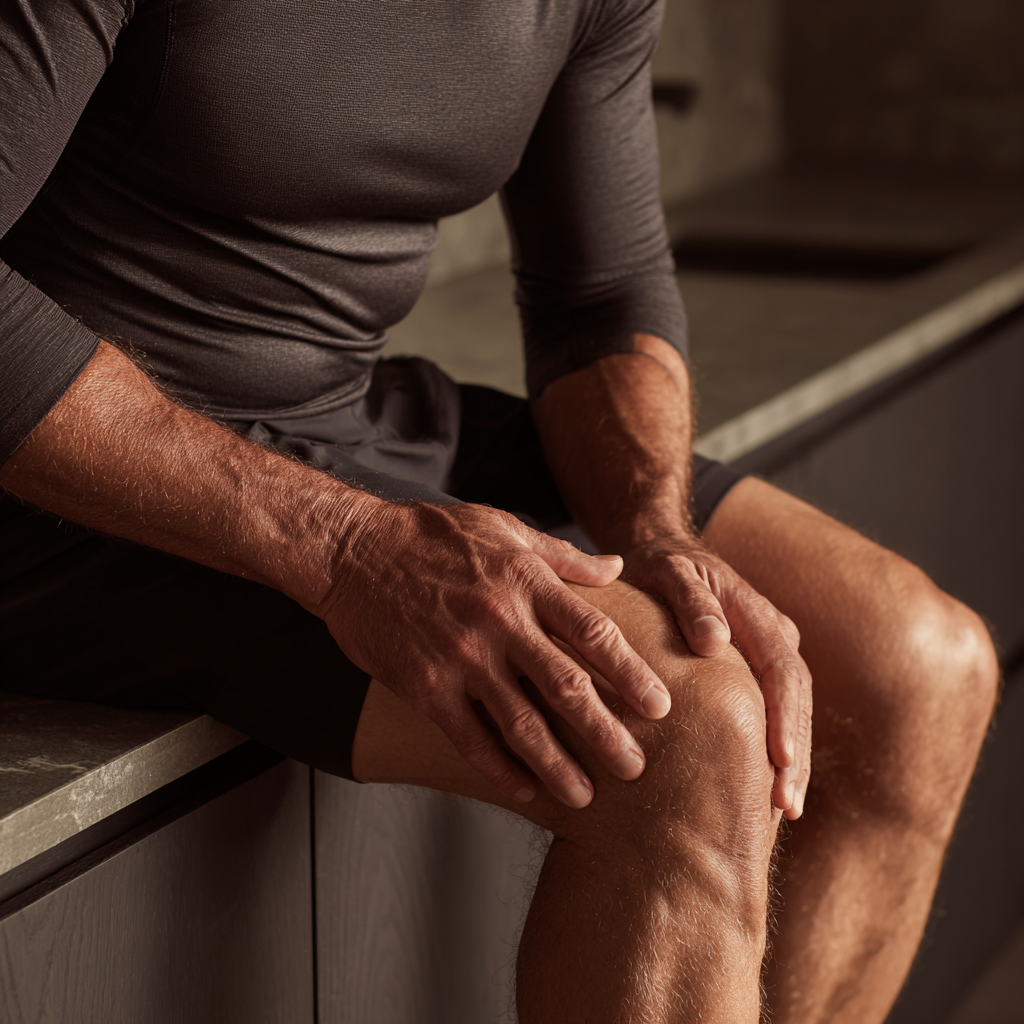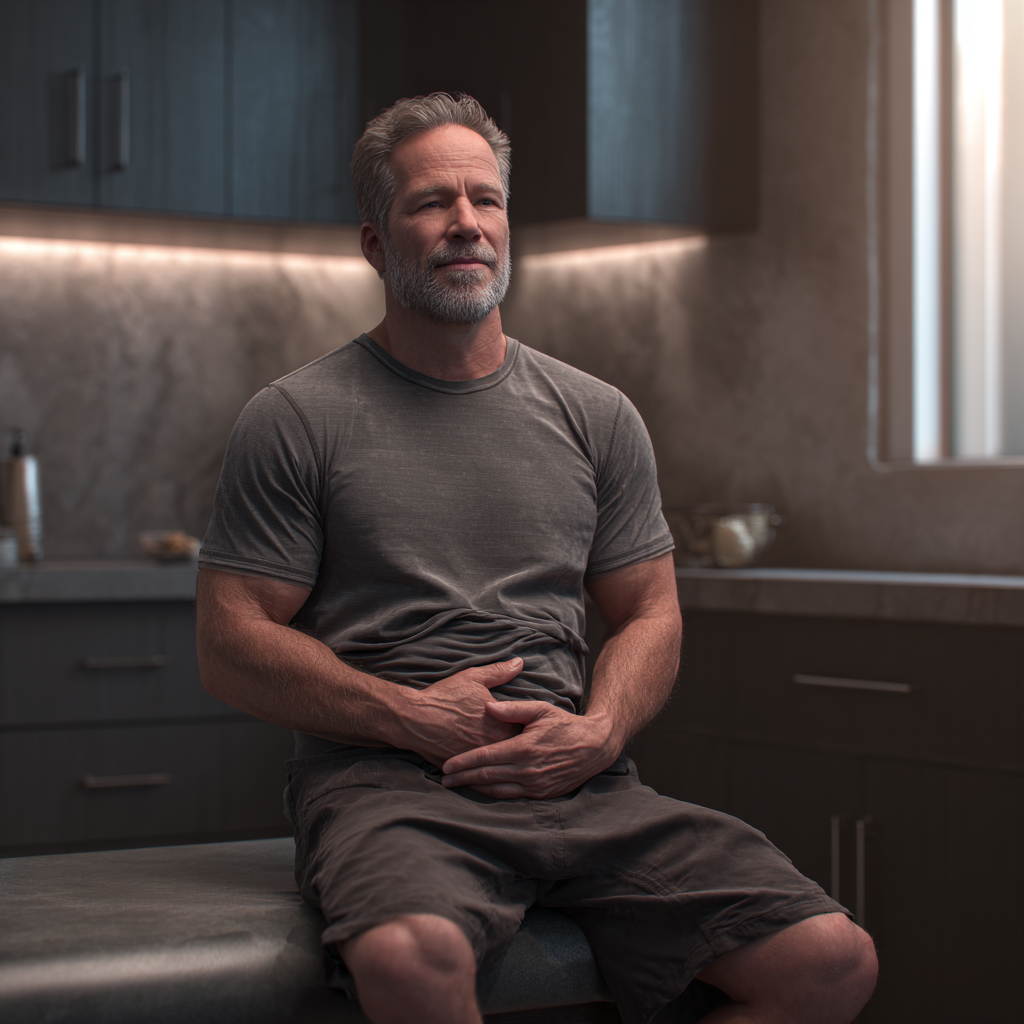Inside Adipose-Derived Stem Cell Therapy
Unlock powerful regenerative cells from your body's own adipose tissue for advanced musculoskeletal healing. Adipose-derived therapy delivers concentrated stem cells, growth factors, and regenerative proteins harvested from fat tissue directly to damaged joints, tendons, and ligaments. This minimally invasive cellular treatment provides high stem cell yields with easier collection than bone marrow, making it ideal for osteoarthritis, chronic tendon injuries, cartilage damage, and conditions requiring tissue regeneration. When you need cellular healing capacity with minimal discomfort, adipose therapy offers exceptional regenerative potential through ultrasound-guided precision.

Abundant Cells.
Powerful Healing.
At Paragon Sports Medicine, we harness one of your body's richest sources of regenerative cells – adipose tissue. Adipose-derived stem cell therapy accesses mesenchymal stem cells (MSCs) from fat tissue, which contains significantly higher stem cell concentrations than bone marrow and can be harvested through a simple, minimally invasive mini-liposuction procedure. These adipose-derived stem cells (ADSCs) can differentiate into cartilage, bone, and tendon cells while releasing powerful growth factors including VEGF, HGF, IGF-1, and bFGF that promote tissue repair, reduce inflammation, and support regeneration. The stromal vascular fraction (SVF) isolated from adipose tissue contains not only stem cells but also pericytes, endothelial cells, and bioactive proteins that work synergistically to restore damaged musculoskeletal tissue. For patients seeking cellular regeneration with easier, less invasive harvesting than bone marrow aspiration, adipose therapy provides exceptional healing capacity.

The Science Behind
Adipose Regeneration
Adipose-derived therapy delivers concentrated stem cells and regenerative factors that rebuild damaged tissue:
High-Yield Stem Cell Harvest
Adipose tissue contains 100-1000 times more stem cells per volume than bone marrow, providing abundant regenerative cells through minimally invasive collection.
Multipotent Stem Cell Differentiation
Adipose-derived stem cells differentiate into cartilage (chondrocytes), bone (osteoblasts), and tendon cells (tenocytes), enabling true tissue regeneration.
Potent Growth Factor Release
ADSCs secrete VEGF (vascularization), HGF (tissue repair), IGF-1 (cell growth), bFGF (healing), and TGF-β (matrix production) for comprehensive tissue restoration.
Anti-Inflammatory Modulation
Stem cells possess immunomodulatory properties that reduce chronic inflammation, create optimal healing environments, and support long-term tissue health.
Paracrine Signaling & Tissue Support
Beyond direct differentiation, adipose cells release bioactive molecules that recruit native stem cells, enhance cellular activity, and orchestrate the entire regeneration cascade.




Cellular Healing for
Diverse Conditions
Adipose-derived therapy is effective for conditions requiring cellular regeneration and tissue repair. The high concentration of stem cells and growth factors makes this treatment particularly valuable for joint degeneration, chronic soft tissue injuries, and inflammatory conditions where rebuilding tissue integrity is essential. The easier harvest procedure compared to bone marrow makes adipose therapy an attractive option for patients seeking powerful cellular regeneration with minimal invasiveness.BMAC therapy is reserved for conditions requiring true cellular regeneration – cases where tissue damage is severe, degenerative changes are advanced, or previous treatments have proven insufficient. The concentrated mesenchymal stem cells provide regenerative capacity that platelet therapies cannot deliver alone. Clinical applications demonstrate particular effectiveness for cartilage defects, avascular necrosis, and complex structural injuries where rebuilding tissue architecture is essential for functional restoration. BMAC represents the optimal choice when you need actual cellular regeneration, not just accelerated healing.
Adipose therapy effectively treats:

Osteoarthritis & joint degeneration
Knee, hip, shoulder, and ankle arthritis where adipose stem cells can differentiate into cartilage cells and reduce inflammatory joint damage.

Chronic tendon & ligament injuries
Tennis elbow, Achilles tendinopathy, rotator cuff tears, plantar fasciitis, ligament sprains, and soft tissue injuries requiring cellular regeneration.
%20.png)
Cartilage defects & soft tissue damage
Cartilage loss, meniscal tears, labral tears, and degenerative conditions where stem cell differentiation can restore tissue structure and function.
Your Journey
to Cellular Recovery
Harvest Site Preparation
You'll be positioned comfortably for access to the adipose collection site (typically abdomen or flanks). The area is cleaned, sterilized, and local anesthesia is administered to ensure comfort during the mini-liposuction procedure.

Adipose Tissue Collection
Using a small cannula, Dr. Garten performs a mini-liposuction to collect adipose tissue. The procedure is well-tolerated under local anesthesia and typically takes 15-20 minutes. Only a small amount of fat is needed (typically 30-60cc).

Cellular Processing & Concentration
Your adipose tissue is processed to isolate the stromal vascular fraction (SVF) containing stem cells, growth factors, and regenerative proteins. Processing methods concentrate the therapeutic cells while removing unnecessary components. This takes 30-45 minutes.

Ultrasound-Guided Injection
Using real-time musculoskeletal ultrasound, Dr. Garten precisely injects the concentrated adipose-derived cells directly into damaged tissue – whether joint, tendon, or ligament – ensuring maximum cellular delivery for optimal regeneration.

Recovery & Regeneration Protocol
You'll receive activity modification guidelines, recovery strategies, and a phased rehabilitation plan optimized for cellular regeneration timelines. Follow-up assessments track your tissue healing progress over subsequent months.


Your Cellular Regeneration Timeline
Adipose therapy initiates a biological regeneration process that unfolds over several months. Stem cells require time to differentiate, proliferate, and rebuild tissue. Understanding this timeline helps set realistic expectations.
Precision Expertise. Advanced Cellular Medicine.
Adipose-derived therapy requires specialized technique, proper processing protocols, and comprehensive understanding of cellular regeneration. Success depends on critical factors that distinguish expert care:
With over two decades of regenerative medicine experience and advanced training in cellular therapies, Dr. Garten brings elite expertise to every adipose procedure. His comprehensive approach gives you the best opportunity for meaningful functional restoration.

Choosing the Right Regenerative Approach

Adipose vs. BMAC
Key differences: Both provide mesenchymal stem cells but from different sources. Adipose tissue offers significantly higher stem cell yield (100-1000x more per volume) and easier, less invasive harvesting with minimal discomfort. Bone marrow may demonstrate stronger bone-forming and cartilage-forming potential for certain conditions. Adipose is often preferred when high cell numbers are desired with minimal procedural discomfort. Dr. Garten selects the optimal source based on your specific condition and treatment goals.
Adipose vs. PRP
When adipose is preferred: PRP delivers platelets and growth factors but no stem cells capable of regenerating lost tissue. Adipose therapy is chosen when cellular regeneration is required – cartilage loss, severe tendon damage, or conditions where tissue must be rebuilt. For moderate injuries, PRP may suffice. For severe degeneration requiring stem cells, adipose provides cellular capacity PRP cannot deliver.
Adipose vs. Surgery
Regenerative alternative: For many conditions traditionally requiring surgery – cartilage damage, joint replacement, tendon repair – adipose therapy offers regenerative treatment without surgical trauma. It preserves native anatomy, avoids hardware or implants, requires no general anesthesia, and maintains future surgical options. However, some conditions still require surgery, and Dr. Garten provides honest assessment of whether adipose therapy is appropriate.
Combination Therapies
Synergistic approach: Adipose therapy can be combined with PRP for enhanced results – stem cells provide regenerative capacity while platelets create optimal growth environments. Some patients benefit from sequential treatments (adipose first for cellular regeneration, then PRP to support maturation) or combination injection. Dr. Garten designs personalized protocols based on condition complexity.
Abundant Stem Cell Yield
Adipose tissue contains 100-1000 times more stem cells per volume than bone marrow, providing exceptional regenerative cell numbers through a single, minimally invasive harvest procedure.
Minimally Invasive Collection
Mini-liposuction under local anesthesia is significantly less invasive and more comfortable than bone marrow aspiration. Most patients experience minimal discomfort during and after harvest, with faster recovery at the collection site.
True Cellular Regeneration
Adipose stem cells differentiate into cartilage, bone, and tendon cells – literally regenerating tissue rather than just accelerating healing. This represents actual tissue rebuilding at the cellular level.
Potent Growth Factor Profile
Adipose cells release powerful growth factors (VEGF, HGF, IGF-1, bFGF, TGF-β) that promote vascularization, reduce inflammation, stimulate cellular activity, and support comprehensive tissue repair.
Autologous Safety
Using only your own cells eliminates risks of rejection, disease transmission, or allergic reaction. The autologous nature provides excellent safety with minimal risk profile.
Surgical Alternative
For many conditions – particularly osteoarthritis, cartilage defects, and chronic tendon tears – adipose therapy offers effective regenerative treatment without surgical trauma, lengthy rehabilitation, or permanent anatomical changes, while preserving future treatment options.
The Adipose Advantage

Adipose Therapy:
Your Questions, Answered
Adipose tissue is collected through a mini-liposuction procedure performed under local anesthesia in our office. The harvest site (typically abdomen or flanks) is numbed completely, and most patients report minimal discomfort during the procedure – often describing only pressure or tugging sensations. The procedure takes 15-20 minutes. Afterward, the harvest site may feel sore similar to post-workout muscle soreness, with possible bruising or mild swelling for 3-5 days. Most patients find adipose collection significantly more comfortable than bone marrow aspiration and return to normal activities quickly. Only a small amount of fat is needed (30-60cc), so there's minimal cosmetic change at the harvest site.
Only a small amount of adipose tissue is required – typically 30-60 milliliters (approximately 2-4 tablespoons). Because fat tissue contains such high concentrations of stem cells (100-1000x more than bone marrow per volume), we can obtain millions of regenerative cells from minimal fat harvest. This small volume is collected through a tiny incision and causes minimal cosmetic change. Nearly all patients have sufficient adipose tissue for the procedure, regardless of body type. Even individuals with low body fat typically have adequate subcutaneous fat in the abdomen or flanks for successful stem cell harvest.
Both adipose and bone marrow provide mesenchymal stem cells (MSCs) capable of regenerating tissue, but they differ in several ways. Adipose tissue contains 100-1000 times more stem cells per volume, making harvest more efficient with higher cell yields. Adipose collection is less invasive and more comfortable than bone marrow aspiration. The growth factor profiles differ slightly – adipose cells produce high levels of VEGF (vascularization) and HGF (tissue repair), while bone marrow may demonstrate stronger bone-forming and cartilage-forming potential for certain conditions. Both are effective for osteoarthritis and tendon injuries. Dr. Garten selects the optimal cellular source based on your specific condition, treatment goals, and individual factors.
Because adipose therapy stimulates actual tissue regeneration, results can be long-lasting when successful. Many patients experience sustained improvement for multiple years as regenerated tissue functions biologically. Durability depends on condition severity, age, activity level, biomechanics, ongoing degenerative processes, and rehabilitation adherence. Adipose therapy doesn't stop aging or prevent future injury, but regenerated tissue can provide meaningful long-term functional improvement. Some patients may eventually require additional treatment if degeneration progresses, though regenerated tissue often demonstrates better resilience than untreated degenerative tissue. Long-term outcomes continue to be studied as adipose therapy represents evolving advancement in regenerative medicine.
Most patients receive a single adipose treatment to initiate cellular regeneration. Depending on condition severity and initial response, some may benefit from a second treatment 6-12 months later. Unlike PRP series, adipose therapy typically isn't performed repeatedly due to the cellular nature of treatment and extended regeneration timeline required for stem cells to differentiate and produce tissue. Dr. Garten assesses your response through clinical evaluation and potentially imaging to determine if additional treatment is warranted. Some patients combine initial adipose therapy with subsequent PRP treatments to support the regeneration process without additional fat harvest.
Success rates vary based on the condition treated, severity, patient age, and individual factors. Published literature suggests approximately 60-75% of appropriate candidates experience meaningful improvement with adipose therapy for osteoarthritis, though results vary widely. Factors associated with better outcomes include younger age, less severe degeneration, good overall health, appropriate patient selection, and rehabilitation adherence. Adipose therapy tends to be most effective for moderate osteoarthritis, cartilage defects, and chronic tendon injuries where viable tissue remains that can respond to cellular signals. Advanced bone-on-bone arthritis with complete cartilage loss may have lower success rates. Dr. Garten provides realistic expectations based on your specific condition during consultation.
For many patients with moderate-to-severe osteoarthritis, cartilage damage, or chronic tendon tears, adipose therapy offers a viable alternative that can delay or potentially eliminate the need for surgery. Success depends on degeneration severity, remaining tissue quality, and individual regenerative capacity. Patients with some remaining cartilage and earlier-stage disease tend to achieve better outcomes. Those with complete cartilage loss or very advanced degeneration may still require surgery, though adipose therapy can be attempted first without compromising future surgical options. Even when adipose therapy doesn't completely eliminate the need for surgery, it often provides years of improved function and quality of life, allowing patients to delay surgical intervention.
Adipose therapy costs reflect the specialized procedure, processing equipment, sterile consumables, extended procedure time, and cellular therapy expertise required. Costs vary depending on condition complexity and whether combination therapies are used. Our office provides transparent pricing during consultation. While adipose therapy represents an investment, many patients find it cost-effective compared to ongoing pain management, repeated treatments, or surgical intervention with associated costs and recovery time. We provide documentation for HSA/FSA reimbursement.
Like most regenerative medicine procedures, adipose-derived stem cell therapy is not typically covered by insurance and is considered out-of-pocket expense. Insurance companies generally classify autologous cellular therapies as investigational despite growing clinical evidence. Our office provides itemized documentation and procedure codes for HSA/FSA accounts or potential partial reimbursement submission, though coverage is not guaranteed. We recommend contacting your insurance provider to inquire about any coverage for autologous adipose-derived cellular procedures.
Yes, adipose therapy is often combined with other regenerative treatments for synergistic effect. Common combinations include:
Adipose + BMAC: Different MSC sources may complement each other for complex conditions
Adipose followed by PRP: Initial adipose for cellular regeneration, then PRP 3-6 months later to support tissue maturation
Adipose + Peptide Therapy: Systemic peptides optimize healing capacity and cellular activity
Adipose + Physical Therapy: Essential for tissue maturation, load tolerance, and functional restoration
Dr. Garten designs personalized treatment protocols that may incorporate multiple modalities to optimize your regenerative outcome.
Ideal candidates typically have moderate-to-severe osteoarthritis, cartilage defects, chronic tendon injuries, or degenerative conditions where cellular regeneration is beneficial and conservative treatments have been insufficient. You may be a good candidate if you have knee/hip/shoulder arthritis with remaining cartilage, tendinopathy or tendon tears, ligament injuries, cartilage damage, or conditions requiring stem cell therapy. You're likely NOT a good candidate if you have active infection, blood clotting disorders, complete bone-on-bone arthritis with severe deformity, unrealistic expectations, or unwillingness to follow extended rehabilitation protocols. Dr. Garten conducts comprehensive evaluation including clinical examination, imaging review, and discussion of goals to determine if adipose therapy is appropriate for your specific situation.
Adipose tissue is collected through a mini-liposuction procedure performed under local anesthesia in our office. The harvest site (typically abdomen or flanks) is numbed completely, and most patients report minimal discomfort during the procedure – often describing only pressure or tugging sensations. The procedure takes 15-20 minutes. Afterward, the harvest site may feel sore similar to post-workout muscle soreness, with possible bruising or mild swelling for 3-5 days. Most patients find adipose collection significantly more comfortable than bone marrow aspiration and return to normal activities quickly. Only a small amount of fat is needed (30-60cc), so there's minimal cosmetic change at the harvest site.
Only a small amount of adipose tissue is required – typically 30-60 milliliters (approximately 2-4 tablespoons). Because fat tissue contains such high concentrations of stem cells (100-1000x more than bone marrow per volume), we can obtain millions of regenerative cells from minimal fat harvest. This small volume is collected through a tiny incision and causes minimal cosmetic change. Nearly all patients have sufficient adipose tissue for the procedure, regardless of body type. Even individuals with low body fat typically have adequate subcutaneous fat in the abdomen or flanks for successful stem cell harvest.
Both adipose and bone marrow provide mesenchymal stem cells (MSCs) capable of regenerating tissue, but they differ in several ways. Adipose tissue contains 100-1000 times more stem cells per volume, making harvest more efficient with higher cell yields. Adipose collection is less invasive and more comfortable than bone marrow aspiration. The growth factor profiles differ slightly – adipose cells produce high levels of VEGF (vascularization) and HGF (tissue repair), while bone marrow may demonstrate stronger bone-forming and cartilage-forming potential for certain conditions. Both are effective for osteoarthritis and tendon injuries. Dr. Garten selects the optimal cellular source based on your specific condition, treatment goals, and individual factors.
Because adipose therapy stimulates actual tissue regeneration, results can be long-lasting when successful. Many patients experience sustained improvement for multiple years as regenerated tissue functions biologically. Durability depends on condition severity, age, activity level, biomechanics, ongoing degenerative processes, and rehabilitation adherence. Adipose therapy doesn't stop aging or prevent future injury, but regenerated tissue can provide meaningful long-term functional improvement. Some patients may eventually require additional treatment if degeneration progresses, though regenerated tissue often demonstrates better resilience than untreated degenerative tissue. Long-term outcomes continue to be studied as adipose therapy represents evolving advancement in regenerative medicine.
Most patients receive a single adipose treatment to initiate cellular regeneration. Depending on condition severity and initial response, some may benefit from a second treatment 6-12 months later. Unlike PRP series, adipose therapy typically isn't performed repeatedly due to the cellular nature of treatment and extended regeneration timeline required for stem cells to differentiate and produce tissue. Dr. Garten assesses your response through clinical evaluation and potentially imaging to determine if additional treatment is warranted. Some patients combine initial adipose therapy with subsequent PRP treatments to support the regeneration process without additional fat harvest.
Success rates vary based on the condition treated, severity, patient age, and individual factors. Published literature suggests approximately 60-75% of appropriate candidates experience meaningful improvement with adipose therapy for osteoarthritis, though results vary widely. Factors associated with better outcomes include younger age, less severe degeneration, good overall health, appropriate patient selection, and rehabilitation adherence. Adipose therapy tends to be most effective for moderate osteoarthritis, cartilage defects, and chronic tendon injuries where viable tissue remains that can respond to cellular signals. Advanced bone-on-bone arthritis with complete cartilage loss may have lower success rates. Dr. Garten provides realistic expectations based on your specific condition during consultation.
For many patients with moderate-to-severe osteoarthritis, cartilage damage, or chronic tendon tears, adipose therapy offers a viable alternative that can delay or potentially eliminate the need for surgery. Success depends on degeneration severity, remaining tissue quality, and individual regenerative capacity. Patients with some remaining cartilage and earlier-stage disease tend to achieve better outcomes. Those with complete cartilage loss or very advanced degeneration may still require surgery, though adipose therapy can be attempted first without compromising future surgical options. Even when adipose therapy doesn't completely eliminate the need for surgery, it often provides years of improved function and quality of life, allowing patients to delay surgical intervention.
Adipose therapy costs reflect the specialized procedure, processing equipment, sterile consumables, extended procedure time, and cellular therapy expertise required. Costs vary depending on condition complexity and whether combination therapies are used. Our office provides transparent pricing during consultation. While adipose therapy represents an investment, many patients find it cost-effective compared to ongoing pain management, repeated treatments, or surgical intervention with associated costs and recovery time. We provide documentation for HSA/FSA reimbursement.
Like most regenerative medicine procedures, adipose-derived stem cell therapy is not typically covered by insurance and is considered out-of-pocket expense. Insurance companies generally classify autologous cellular therapies as investigational despite growing clinical evidence. Our office provides itemized documentation and procedure codes for HSA/FSA accounts or potential partial reimbursement submission, though coverage is not guaranteed. We recommend contacting your insurance provider to inquire about any coverage for autologous adipose-derived cellular procedures.
Yes, adipose therapy is often combined with other regenerative treatments for synergistic effect. Common combinations include:
Adipose + BMAC: Different MSC sources may complement each other for complex conditions
Adipose followed by PRP: Initial adipose for cellular regeneration, then PRP 3-6 months later to support tissue maturation
Adipose + Peptide Therapy: Systemic peptides optimize healing capacity and cellular activity
Adipose + Physical Therapy: Essential for tissue maturation, load tolerance, and functional restoration
Dr. Garten designs personalized treatment protocols that may incorporate multiple modalities to optimize your regenerative outcome.
Ideal candidates typically have moderate-to-severe osteoarthritis, cartilage defects, chronic tendon injuries, or degenerative conditions where cellular regeneration is beneficial and conservative treatments have been insufficient. You may be a good candidate if you have knee/hip/shoulder arthritis with remaining cartilage, tendinopathy or tendon tears, ligament injuries, cartilage damage, or conditions requiring stem cell therapy. You're likely NOT a good candidate if you have active infection, blood clotting disorders, complete bone-on-bone arthritis with severe deformity, unrealistic expectations, or unwillingness to follow extended rehabilitation protocols. Dr. Garten conducts comprehensive evaluation including clinical examination, imaging review, and discussion of goals to determine if adipose therapy is appropriate for your specific situation.
Schedule a
consultation
We don't just treat injuries – we help regenerate tissue and unlock your body's full potential. Whether you're facing joint degeneration, chronic soft tissue damage, or seeking cellular regeneration with minimal invasiveness, our programs combine clinical expertise, cutting-edge cellular biology, and proven protocols.
Our comprehensive approach integrates advanced diagnostics, precise ultrasound-guided delivery, personalized rehabilitation, and recovery optimization to support your body's regenerative capacity at every stage. Cellular healing isn't accidental – it's intentional.
Schedule a
consultation
We don't just treat injuries – we help regenerate tissue and unlock your body's full potential. Whether you're facing joint degeneration, chronic soft tissue damage, or seeking cellular regeneration with minimal invasiveness, our programs combine clinical expertise, cutting-edge cellular biology, and proven protocols.
Our comprehensive approach integrates advanced diagnostics, precise ultrasound-guided delivery, personalized rehabilitation, and recovery optimization to support your body's regenerative capacity at every stage. Cellular healing isn't accidental – it's intentional.
